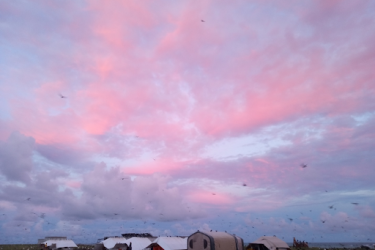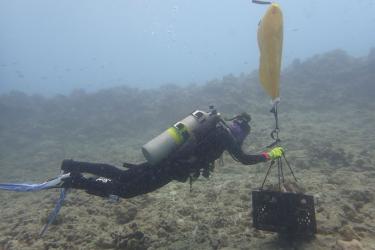On November 6–7, 2019, several federal, state, university, and NGO partners hosted a symposium to discuss coral bleaching in Hawai‘i—and how to combat this growing threat.
The Hawai‘i 2nd Coral Restoration and Bleaching Symposium was held at Coconut Island, O‘ahu, and hosted by the Hawai‘i Institute of Marine Biology (HIMB). It brought together coral experts and representatives from across the state. Participants included NOAA, the Department of Land and Natural Resources’ Division of Aquatic Resources (DAR), the University of Hawai‘i, The Nature Conservancy, community organizations, and local aquariums, among others.
The meeting helped scientists and resource managers share critical information, provided new networking opportunities, and cemented collaboration in upcoming projects. “The symposium also helped identify management and science priorities for the community to address in the near future,” says symposium co-organizer Dr. Paulo Maurin, a contracted Hawai‘i management liaison with NOAA’s Office for Coastal Management.
“We had more than 100 participants and 27 presentations on bleaching and restoration,” Maurin says. “Eighteen different organizations present at this symposium—a much larger and more diverse community compared with the very first symposium held two years ago. The coral restoration community in Hawai‘i continues to grow.”
The presentations and group discussions covered a wide range of topics, including:
- The 2019 marine heat wave in Hawai‘i.
- The evolving science behind how and why coral bleaching occurs.
- How the science community responds to coral bleaching.
- How citizen science can help improve the monitoring of coral bleaching events.
- What can be done to increase coral reef resilience.
- Ideas for preserving and restoring the rare and endemic coral species of Hawai‘i.
- How to restore important reef-building species in Hawai‘i.
The symposium provided a forum for participants to share information about the recent coral bleaching event caused by prolonged high water temperatures across the main Hawaiian Islands. The Hawai‘i Coral Bleaching Collaborative, led by the state, is coordinating monitoring and reporting efforts to assess the extent and the severity of the event.
“During these short-term events, which are becoming more frequent and can have long lasting effects in the form of coral mortality across our islands, it is critical that we come together to more effectively monitor and, even more importantly, manage this current and growing environmental problem,” says Dr. David Delaney, the State of Hawai‘i’s Coral Planner and a co-organizer of the symposium.
Additionally, he notes, for the first time, the community was integral in reporting bleaching through an online coral bleaching tracker tool.
By bringing scientists and resource managers together in one room, the workshop will ensure that science drives future conservation strategies, added co-organizer Dr. Matthew Parry, a fishery biologist with the NOAA Restoration Center and the Damage Assessment, Remediation and Restoration Program. During the symposium, for instance, coral experts discussed ways to improve on their existing coral conservation tools and even develop new restoration techniques.
“HIMB is conducting cutting-edge research on coral resilience and restoration,” says Dr. Zac Forsman, an HIMB researcher and co-organizer of the symposium. “Researchers presented work on how corals grow and adapt to future conditions, genetic indicators of coral bleaching, new 3D mapping methods, antibiotic treatments, assisted evolution, microfragmentation, cryopreservation, restoration assays, and a floating nursery for coral and juvenile fish.”
The DAR Coral Restoration Nursery is using the microfragmentation and fusion method. It is growing corals from the size of a softball to as large as 1 meter in less than a year. DAR used this method to grow and plant rare corals this year. The Nursery also serves as an “ark” for rare corals in collaboration with the Maui Ocean Center.
Another tool that NOAA, DAR, and HIMB are collaborating on is a 20-foot-wide coral nursery platform. Parry and partners installed the platform in the waters near the Honolulu Airport Reef Runway of Oʻahu in May 2018. Colonies that have detached from the reef (due to storms and other disturbances) are placed on the nursery. There, they can safely recover and grow until they’re ready to be transplanted back to the reef.
Scientists at HIMB are working to identify which coral colonies on the nursery may be more naturally resistant to bleaching events. These resilient corals will then be outplanted into test reefs to see if they can propagate. The goal is to eventually make the reef, as a whole, more resilient to heat-induced bleaching.
“We’re trying to understand how different corals react to stresses that cause bleaching,” Parry says. “We want to take advantage of their biology and ecology to maximize the resiliency of the reef.”
Prior to 1996, coral bleaching was rare in Hawaiʻi. But as ocean temperatures rise, coral bleaching appears to be increasing at an alarming rate. Bleaching events have now also occurred in Hawaiʻi in 2014, 2016, and 2019. Researchers, resource managers, non-profit organizations, and community groups are increasing their efforts and coordination to slow or prevent the loss of our vital reefs.
Proceedings from the symposium will be available online by the end of 2019.



